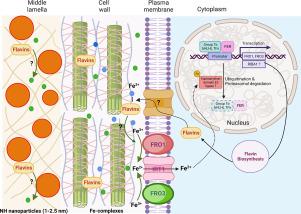NanoImpact ( IF 4.9 ) Pub Date : 2022-12-05 , DOI: 10.1016/j.impact.2022.100444 Amarjeet Singh 1 , Maria Gracheva 2 , Viktória Kovács Kis 3 , Áron Keresztes 4 , Máté Sági-Kazár 1 , Brigitta Müller 5 , Fruzsina Pankaczi 1 , Waqas Ahmad 1 , Krisztina Kovács 6 , Zoltán May 7 , Gyula Tolnai 8 , Zoltán Homonnay 6 , Ferenc Fodor 5 , Zoltán Klencsár 9 , Ádám Solti 5

|
Nanoscale Fe containing particles can penetrate the root apoplast. Nevertheless, cell wall size exclusion questions that for Fe mobilisation, a close contact between the membrane integrating FERRIC REDUCTASE OXIDASE (FRO) enzymes and Fe containing particles is required. Haematite nanoparticle suspension, size of 10–20 nm, characterized by 57Fe Mössbauer spectroscopy, TEM, ICP and SAED was subjected to Fe utilisation by the flavin secreting model plant cucumber (Cucumis sativus). Alterations in the structure and distribution of the particles were revealed by 57Fe Mössbauer spectroscopy, HRTEM and EDS element mapping. Biological utilisation of Fe resulted in a suppression of Fe deficiency responses (expression of CsFRO 1, 2 & 3 and RIBOFLAVIN A1; CsRIBA1 genes and root ferric chelate reductase activity). Haematite nanoparticles were stacked in the middle lamella of the apoplast. Fe mobilisation is evidenced by the reduction in the particle size. Fe release from nanoparticles does not require a contact with the plasma membrane. Parallel suppression in the CsFRO 1&3 and CsRIBA1 transcript amounts support that flavin biosynthesis is an inclusive Fe deficiency response involved in the reduction-based Fe utilisation of Cucumis sativus roots. CsFRO2 is suggested to play a role in the intracellular Fe homeostasis.
中文翻译:

纳米赤铁矿的质外体利用启动了黄瓜中 RIBA1 和 FRO1 和 3 的平行抑制
纳米级含铁颗粒可以穿透根质外体。然而,细胞壁尺寸排除问题表明,对于 Fe 动员,集成铁还原酶氧化酶 (FRO) 酶的膜与含 Fe 颗粒之间需要紧密接触。赤铁矿纳米颗粒悬浮液,尺寸为 10-20 nm,通过57 Fe 穆斯堡尔光谱、TEM、ICP 和 SAED 表征黄素分泌模型植物黄瓜 ( Cucumis sativus )对 Fe 的利用。57 Fe Mössbauer 光谱、HRTEM 和 EDS 元素映射揭示了颗粒结构和分布的变化。铁的生物利用导致铁缺乏反应的抑制(CsFRO 1、2和3和核黄素 A1 ; CsRIBA1基因和根铁螯合还原酶活性)。赤铁矿纳米颗粒堆积在质外体的中间薄层中。颗粒尺寸的减小证明了 Fe 流动。从纳米颗粒中释放 Fe 不需要与质膜接触。CsFRO 1&3和CsRIBA1转录物量的平行抑制支持黄素生物合成是一种包容性缺铁反应,涉及黄瓜根的基于还原的铁利用。CsFRO2 被认为在细胞内 Fe 稳态中发挥作用。



























 京公网安备 11010802027423号
京公网安备 11010802027423号